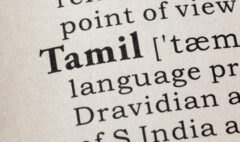How to Write a Formal Email in Tamil
How to Write a Formal Email in Tamil
How to Write a Formal Email in Tamil: A Guide to Professional Communication
In today’s interconnected business world, the email remains the primary and most important form of professional communication. While English is often the default, there are many situations in the Tamil-speaking world where writing a clear, respectful, and professional email in Tamil is either a necessity or a significant advantage. Whether you are applying for a job, communicating with a government office, or corresponding with a senior business partner, knowing how to compose a formal Tamil email is a crucial skill. It is a key component of effective business communication in Tamil and a hallmark of true professional fluency.
The rules and the tone of a formal email are different from a casual chat. It requires a more structured format, a more respectful vocabulary, and an understanding of the cultural nuances of formal address. This guide will provide you with a step-by-step framework and the essential phrases you need for professional Tamil writing. This is your toolkit for crafting a formal email or a formal letter in Tamil with confidence and precision.
The Core Principle: Respect and Formality
The guiding principle in all formal Tamil writing is a deep sense of respect (மரியாதை – mariyāthai). This is reflected in the choice of pronouns, the formal verb conjugations, and the polite opening and closing phrases. Unlike a casual email to a friend, a formal email should always maintain a respectful and slightly distant tone.
Part 1: The Salutation (விளிப்பு – Viḷippu) – The Opening Greeting
The way you begin your email sets the entire tone. You must choose a respectful and appropriate salutation.
To a Specific, Known Person:
- If you know their name and they are a respected elder or a superior:
“மதிப்பிற்குரிய திரு./திருமதி./செல்வி [Name] அவர்களுக்கு,” (Matippiṟkuriya Tiru./Tirumati./Celvi [Name] avarkaḷukku,)
This translates to “To the respected Mr./Mrs./Miss [Name].” The use of “அவர்களுக்கு” (avarkaḷukku) is a highly respectful plural form. - A slightly less formal but still very respectful option:
“அன்புள்ள திரு./திருமதி. [Name],” (Aṉpuḷḷa Tiru./Tirumati. [Name],)
This translates to “Dear Mr./Mrs. [Name].”
When You Don’t Know the Person’s Name:
- To a general office or a male superior:
“மதிப்பிற்குரிய ஐயா,” (Matippiṟkuriya Aiyā,) – “Respected Sir,” - To a female superior:
“மதிப்பிற்குரிய அம்மா,” (Matippiṟkuriya Ammā,) – “Respected Ma’am,”
Part 2: The Opening Line – Stating Your Purpose
After the salutation, your first sentence should clearly and politely state the purpose of your email.
Common Opening Phrases:
- “I am writing this email regarding…” – “நான் இந்த மின்னஞ்சலை … தொடர்பாக எழுதுகிறேன்.” (Nāṉ inta miṉṉañcalai … toṭarpāka eḻutukiṟēṉ.)
Example: “…the job application.” – “…வேலை விண்ணப்பம் தொடர்பாக.” (…vēlai viṇṇappam toṭarpāka.) - “This is in reference to our conversation yesterday.” – “நேற்றைய நமது உரையாடலின் தொடர்பாக இதை எழுதுகிறேன்.” (Nēṟṟaiya namatu uraiyāṭaliṉ toṭarpāka itai eḻutukiṟēṉ.)
- “I am writing to request…” – “நான் …-ஐக் கோரி எழுதுகிறேன்.” (Nāṉ …-aik kōri eḻutukiṟēṉ.)
Example: “…some information.” – “…சில தகவல்களைக் கோரி.” (…cila takavalkaḷaik kōri.)
Part 3: The Body of the Email – Clear and Concise Content
This is where you will convey your main message. The key to effective professional Tamil writing in the body of an email is to be clear, concise, and polite.
- Use Formal Pronouns and Verbs: Always use the formal “you” – “நீங்கள்” (nīṅkaḷ) and the corresponding formal verb endings (e.g., “-ஈர்கள்” [-īrkaḷ]). Avoid the informal “நீ” (nī).
- Keep Your Sentences Clear and to the Point: Avoid overly complex or literary language. The goal is clear business communication.
- Structure with Paragraphs: Break your message into short, logical paragraphs, just as you would in an English email.
Useful Phrases for the Body:
- “Please find the attached document.” – “இணைக்கப்பட்டுள்ள ஆவணத்தைக் காணவும்.” (Iṇaikkappaṭṭuḷḷa āvaṇattaik kāṇavum.)
– “I would like to inform you that…” – “நான் உங்களுக்குத் தெரிவிக்க விரும்புவது என்னவென்றால்…” (Nāṉ uṅkaḷukkut terivikka virumpuvatu eṉṉaveṉṟāl…)
– “As we discussed…” – “நாம் பேசியபடி…” (Nām pēciyapaṭi…)
– “Could you please confirm?” – “தயவுசெய்து உறுதிப்படுத்த முடியுமா?” (Tayavuceytu uṟutippaṭutta muṭiyumā?)
Part 4: The Closing – A Polite and Respectful Finish
The way you end your email is just as important as the way you begin it.
Pre-Closing Lines:
- “Thank you for your time and consideration.” – “உங்கள் நேரத்திற்கும் பரிசீலனைக்கும் நன்றி.” (Uṅkaḷ nērattiṟkum paricīlaṉaikkum naṉṟi.)
- “I look forward to hearing from you.” – “உங்கள் பதிலை ஆவலுடன் எதிர்பார்க்கிறேன்.” (Uṅkaḷ patilai āvaluṭaṉ etirpārkkiṟēṉ.)
- “Please let me know if you have any questions.” – “ஏதேனும் கேள்விகள் இருந்தால், ದಯವಿಟ್ಟು எனக்குத் தெரியப்படுத்தவும்.” (Ētēṉum kēḷvikaḷ iruntāl, tayavuceytu eṉakkut teriyappaṭuttavum.)
The Sign-Off (முடிவுரை – Muṭivurai):
- A very formal and common closing: “இப்படிக்கு,” (Ippaṭikku,) – This is similar to “Yours sincerely,” or “Regards,”
- Followed by your name:
“இப்படிக்கு,
உங்கள் உண்மையுள்ள,
[Your Name]”
(Ippaṭikku,
Uṅkaḷ uṇmaiyuḷḷa,
[Your Name])
This means “Yours truthfully,” and is a very standard and respectful closing for a formal letter or email. - A simpler, modern closing is just “நன்றி,” (Naṉṟi,) – “Thank you,” followed by your name.
A Sample Formal Email
Subject: வேலை விண்ணப்பம் – [Your Name]
மதிப்பிற்குரிய திரு. குமார் அவர்களுக்கு,
நான் [Website Name]-ல் தாங்கள் வெளியிட்டிருந்த [Job Title] பதவிக்கான விளம்பரத்தைப் பார்த்தேன். அந்தப் பதவிக்கு விண்ணப்பிக்கும் பொருட்டு இந்த மின்னஞ்சலை எழுதுகிறேன்.
என் சுயவிவரக் குறிப்பை (resume) இத்துடன் இணைத்துள்ளேன். அதில் என் கல்வித் தகுதிகள் மற்றும் பணி அனுபவம் பற்றிய விவரங்கள் உள்ளன.
இந்த வாய்ப்பு குறித்து மேலும் பேச நான் ஆவலாக உள்ளேன். தங்கள் பதிலை ஆவலுடன் எதிர்பார்க்கிறேன்.
உங்கள் நேரத்திற்கு நன்றி.
இப்படிக்கு,
உங்கள் உண்மையுள்ள,
[Your Name]
[Your Contact Information]
Translation:
Subject: Job Application – [Your Name]
Respected Mr. Kumar,
I saw the advertisement you had posted on [Website Name] for the position of [Job Title]. I am writing this email in order to apply for that position.
I have attached my resume with this. It contains the details of my educational qualifications and work experience.
I am eager to talk more about this opportunity. I am eagerly awaiting your reply.
Thank you for your time.
Yours truthfully,
[Your Name]
[Your Contact Information]
Conclusion: The Language of Professionalism
Crafting a well-written formal Tamil email is a skill that demonstrates a high level of linguistic proficiency and cultural awareness. It is a key part of effective business communication in Tamil. By following this simple structure and by using these respectful and professional phrases, you can ensure that your written communication is always clear, appropriate, and impressive. Mastering the art of the formal letter in Tamil is a powerful way to enhance your professional image and to build strong and successful relationships in the Tamil-speaking world.









